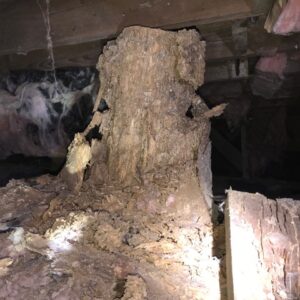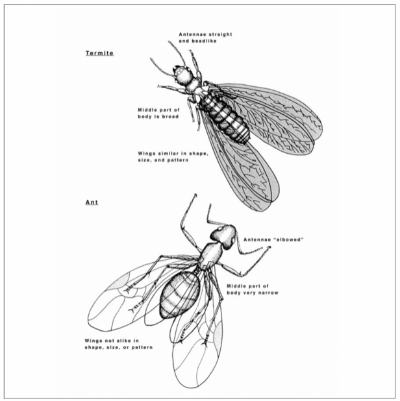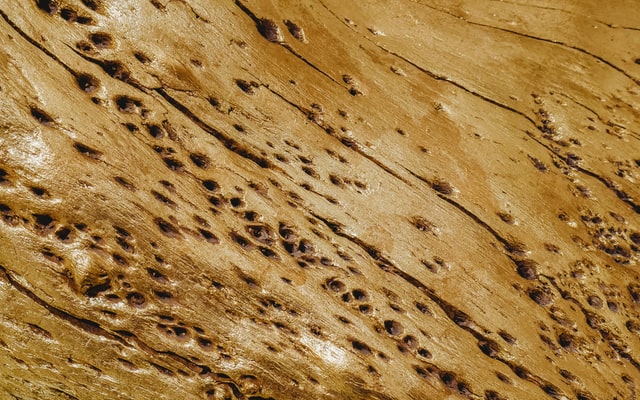
Photo by Yves Cedric Schulze on Unsplash
Your home is a huge investment, and not just for its purchase price. Regular maintenance and repairs add up over time, but are necessary to retain your home’s highest value. One thing you don’t need is extensive damage from wood-destroying insects! Before you purchase a home, it’s best to find out if there has been a previous infestation, and whether current conditions are conducive for a reinfestation. Always get a home inspection before signing the purchase agreement.
Let’s take a look at the types of insects that may be eating your home and what to do about them. We’ll look at termites, carpenter bees, carpenter ants, and wood-boring beetles. You don’t want any of these chewing on your house.
The award for most destructive goes to…

Termites are the most destructive wood-destroying insects. Their nests may be outside your home, but their appetite for cellulase-based food sources may lure them into your home to feed on wood structures. Termites break down the cellulase in wood. It’s their number one delicacy. Trouble is, they can be happily chewing away at your wood for years before you begin to notice the damage.
Since your roofing structure is made of wood, extensive termite damage can cause it to collapse, exposing your home to rain, wind, or snow. The cost of repair can be devastating.
Termites sometimes live under your house, eating away at wood that supports floors above your crawl space. A properly-constructed home should not have wood-to-ground contact. Wood-to-ground supports for subfloors or decks are a prime entryway for termites. When wood is used for support, it should be encased in concrete footers to separate it from the ground. Nor should wood supports be in direct contact with subfloors. One solution is to use steel wood-to-wood caps.
Signs of infestation
Just because you haven’t noticed termites, that doesn’t mean they’re not your housemates. It’s wise to have your home inspected every few years. While most home inspectors are not certified to identify specific wood-destroying insects, they can point out some tell-tale signs and refer you to a certified pest-control specialist. Here’s what the pros look for:
- Mud-like deposits clinging to wood surfaces
- Mud tubes or tunnels that link a ground nest to your homes wooden structure
- Evidence of tunnels in wood or tiny holes
- Buckling paint on wood exteriors
- Discolored drywall that resembles water damage
- Small piles of tiny wings on surfaces
A good offense
The best defense against termites is a good offense. Begin by eliminating conditions that are conducive to infestations, such as:
- Debris piles underneath or around the structure
- Planter boxes attached to or touching structure
- Insufficient ventilation
- Wood-to-ground contact
- Mulch touching structure
- Wood pile in contact or too close to structure
- Wood rot
- Excessive moisture
Click here to see a video of conducive conditions.
Carpenter ants

USDA Graphic.
There’s an internet joke where someone is hearing the song “Close To You,” coming from the ground. He exclaims, “Oh, no! Carpenter ants!”
That’s funny, but finding carpenter ants in your home is dead serious.
Some people mistake swarming (winged) carpenter ants for termites. There are noticeable differences. In the photo at left, the top drawing is a termite, and the bottom drawing is a carpenter ant.
Carpenter ants have a noticeable waist, elbowed antennae, and two sets of wings that are of different lengths. Termite have no visible waist, straight antennae, and all four wings are equal in size.
Carpenter ants don’t eat wood like termites. They will excavate dead and damp wood and dig tunnels in which to nest. If left unrepaired, damp wood will succumb to dry rot, creating the perfect environment for carpenter ants.
If you see winged carpenter ants in your home, there is likely a nest nearby. Like termites, the winged ones are mating. The large ones that look like wasps are queens looking for a new place to make a nest. Now would be a good time to contact a pest control service.
Carpenter bees
Carpenter bees do not eat wood, but they drill circular holes inside the wood to live in it. Many homeowners will discover carpenter bees nesting in frames, eaves, or on the wooden sides of buildings. The bees are large, and the males will swoop at you to scare you off, but only the females can sting, but they usually won’t bother unless you stick your fingers in their holes.
Carpenter bees pose a threat to houses, because they weaken the structural integrity of the wood after years of boring holes. Also, carpenter bee larvae usually live inside the holes, and woodpeckers throw fuel on the fire by pecking and enlarging the nesting holes to eat the larvae.
One way to keep carpenter bees away is to paint or stain all your wood surfaces. Carpenter bees don’t seem to like paints, stains, or varnishes.
Powder post beetles

These critters are second to termites in regard to the kind of damage they can do to your home. They deposit their larvae in wood around your home, and their number one delicacy is the cellulose in wood fibers.
You might see signs of a powder post beetle infestation by the powdery wood residue they leave behind, resembling fine sand.
Powder post beetle larvae are born inside the wood and may happily munch on it for up to five years, leaving it brittle and unfit for structural support. By the time you spot them, damage to your home and roof may be devastating. That’s why the prudent thing to do is schedule an inspection with a certified pest inspector yearly.
An ounce of prevention
You know what “they” say an ounce of prevention is worth. The best way to protect your home and your roof is to arrange for professional inspections at least every two years.
Get a home inspector to check for signs of wood damage. Depending on the findings, the inspector may recommend a licensed pest control inspector to make further determinations.
The best strategy against wood-destroying insects is to be proactive. It’s the keep you keeping your home safe for many years to come.
Set up a pest inspection
Peter Young Home Inspections can arrange for a pest inspection. Click here to make an appointment.